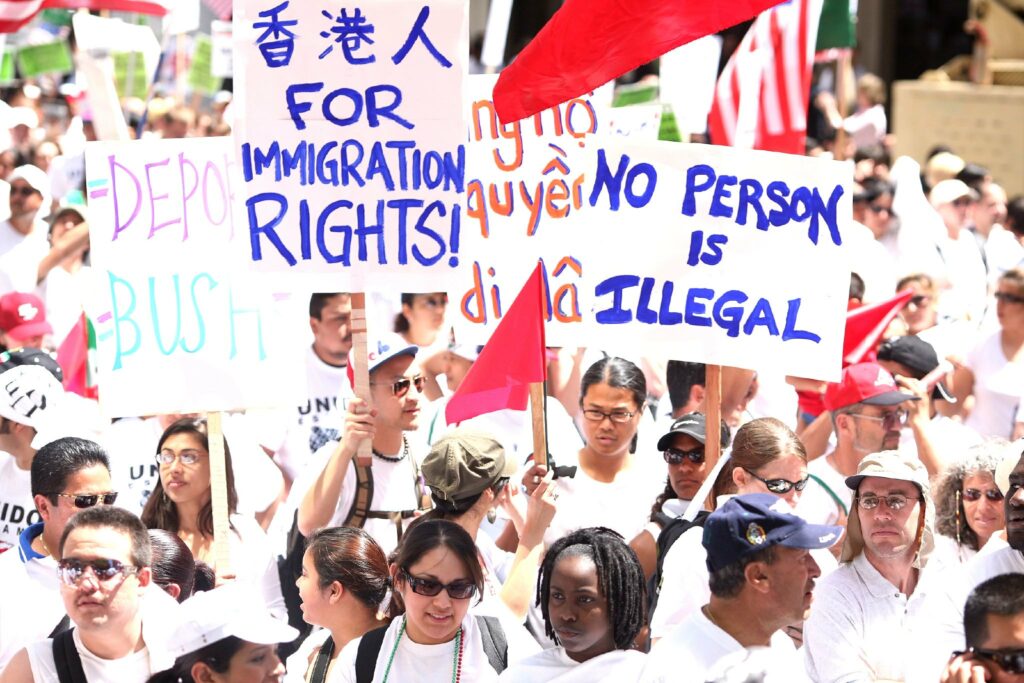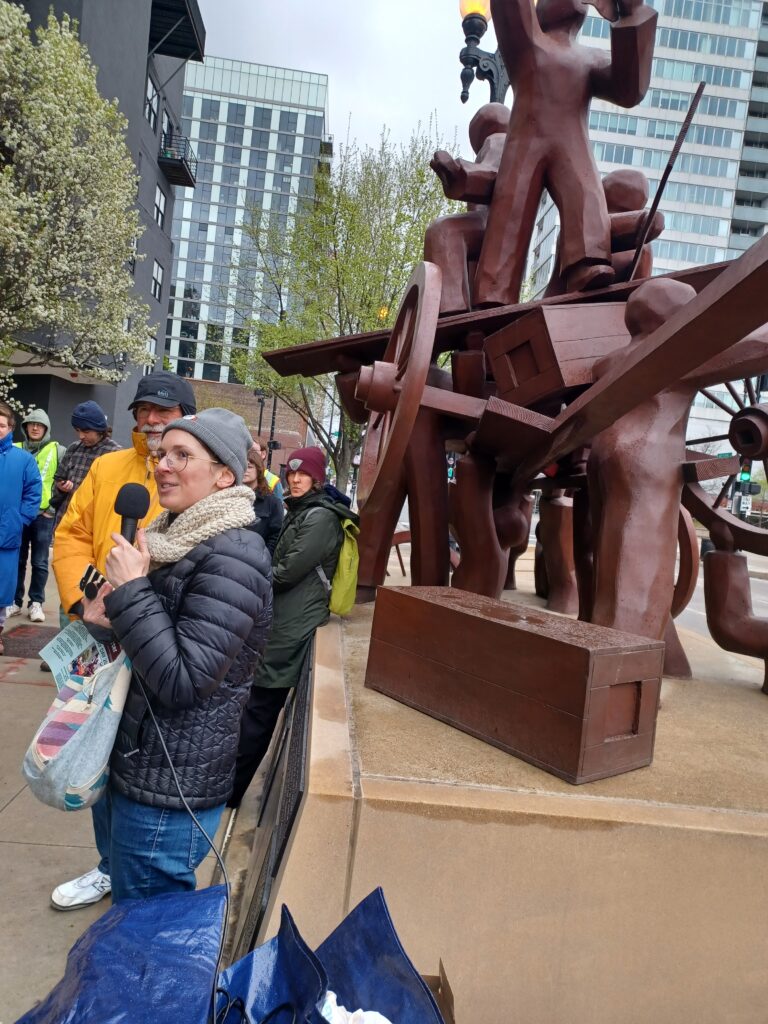May 1, or May Day, marks International Workers’ Day. On this day in 1886, hundreds of thousands of workers across the United States went on strike for the 8-hour workday. At that time, workers of all genders and ages commonly worked 16-hour shifts in brutally oppressive conditions. Thousands of workers died each year in industrial workplaces. They lived in conditions of horrifying poverty.
In Chicago, more than a hundred thousand workers were involved in the uprising. Strikers at various workplaces were beaten, jailed, and killed by the police. Called to a mass meeting, strikers and protesters filled Haymarket Square. On May 3, the police cracked down on this protest, and in the chaos, a bomb went off. Although no one knows who had thrown the bomb or what its intended targets were, eight men–Albert Parsons, August Spies, Samuel Fielden, Oscar Neebe, Michael Schwab, George Engel, Adolph Fischer, and Louis Lingg–were tried and found guilty of conspiracy to murder; four were hanged in spite of international pressure to stop the executions.
August Spies, one of the Haymarket martyrs, said famously during his trial:
If you think that by hanging us, you can stamp out the labor movement…then hang us! Here you will tread upon a spark, but here, and there, and behind you, and in front of you, and everywhere, flames will blaze up. It is a subterranean fire. You cannot put it out. The ground is on fire upon which you stand.
May Day was declared an international workers’ holiday in 1889 and is celebrated around the world by socialists, anarchists, unionists, and other workers to mark this moment of mass workers uprising against capitalist exploitation.
Over the past several years, we have seen a renewal of workers’ struggle from the Teamsters at UPS to workers at Amazon and Starbucks to a rash of strikes and organizing drives at U.S. colleges and universities.
Today we publish this short essay by Joe Allen about the labor tour of Haymarket Square in Chicago, where a memorial to the Haymarket strikers and martyrs stands to remind us that every gain made by working people around the world has come through militant struggle and often at great cost.
On April 22, I participated in the Chicago chapter of the Democratic Socialists of America (DSA) Labor Walking Tour. Despite the rain and a brief shower of snow pellets, fifty to sixty people came out for the tour that began at the Haymarket Martyrs Monument in the West Loop, the site of the old Haymarket Square. The tour wound its way through the Fulton Market area to Greektown to Whitney Young High School and finally to Teamster City. There were several stops highlighting important labor history in Chicago, including the Packinghouse workers’ struggles, Starbucks organizing, the founding of CORE, and finally a presentation by me on the 1997 UPS strike. It was emceed by DSAer Dana Kleifield.
It was a fun event, about two miles total. About half of the crowd were DSA members and the rest were friends or people on the mailing list of the Illinois Labor History Society (ILHS). The ILHS has been around for a long time and was the main organization leading the fight for the creation of a Haymarket memorial within the city limits for decades. The older and, in my opinion, much better Haymarket monument is located in the suburb of Forest Park in Waldheim Cemetery. ILHS is the custodian of that monument.

The walking tour rekindled my interest in the legacy of the Haymarket Martyrs monuments and how history is remembered particularly through public monuments and statues. During the national uprising against racism following the murder of George Floyd in 2020, monuments and statues came under siege or were torn down across the country. Ones that were clearly dedicated to white supremacy, confederated heroes, or to Christopher Columbus were rightly targeted across the country, including here in Chicago.
For over a century, the city of Chicago opposed any monument to the martyrs within the city limits. In fact, the only monument to the Haymarket affair was a police monument that was repeatedly vandalized and bombed throughout the years. Today, it sits protected in the rear of police headquarters at 34th and Michigan. Finally, the ILHS’s efforts bore fruit when Emil Jones, a former Illinois Senate leader, pushed through the funding for it, nearly $300,000, and a dedication ceremony took place in September 2002. However, the Haymarket monument has not been without its controversies.
“It might be a little overdue,” Lois Weisberg, Chicago’s commissioner of cultural affairs, reported to the New York Times at the dedication ceremony. “Some might say 100 years.” I remember being at the ceremony back in 2004, three years after 9-11, and I can’t remember any of the speakers dealing with the broad attack on civil liberties we were living through at that moment. That wasn’t exactly a new story, because the Chicago Federation of Labor (CFL) always had an uncomfortable relationship with Haymarket Martyrs, embracing the 8-hour movement but disavowing the revolutionary anarchism of the movement’s leaders.
The best you can get from the CFL were the remarks of Dennis Gannon, the head of the CFL at the time, who told the crowd,
We get people coming here from all over the world, and the first thing they want to do is visit Haymarket. Haymarket represents the beginning of labor rights in this country. It’s really about our most important right, which is freedom of speech, freedom to protest. If you don’t have that, you’re going to be oppressed.
Yet, for the Martyrs the 8-hour struggle was ultimately about the revolutionary transformation of society.
I remember thinking it was so obscene that Mark Donahue, the head of the Chicago Fraternal Order of Police (FOP) was one of the speakers. “The police are part of the labor movement,” he told the crowd. Four years earlier, Illinois Republican Governor George Ryan declared a moratorium on executions. It was roundly condemned by police unions in the state and virtually the entire Democratic Party-dominated criminal justice establishment in Cook County. No speaker drew a connection between the Martyrs’ executions and Ryan’s moratorium.

“Those men who were hanged are being presented as social democrats or liberal reformers, when in fact they dedicated their whole lives to anarchy and social revolution,” one protester at the monument dedication told the New York Times. “If they were here today, they’d be denouncing this project and everyone involved in it.” Absolutely. The older Haymarket monument was designated a National Historic Landmark in 1997 and another ceremony was held in 1998. I remember a Catholic priest giving a benediction at it and thinking our anarchist comrades are going to rise from the grave and burn down the stage.
While I was never a great fan of the West Loop Haymarket monument, its faceless bubble people, and ambiguous message, which, I thought deliberately muted the events of long ago, it has grown on me over the years. If you wander down to 151 N. Des Plaines on a warm summer day, you’ll find tourists from around the world visiting the monument with their families. Official trade union delegations present plaques dedicated to the Martyrs almost every year on May Day.
For friends and comrades from around the world, the events at Haymarket in 1886 were the birthplace of the modern, international labor movement. Whatever the battles over its messaging, the Haymarket monuments belong to us.
Featured Image credit: picryl.com; modified by Tempest.

